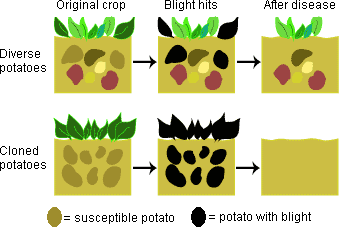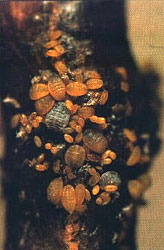
Lack of genetic variation in Irish potatoes contributed to the severity of the Irish potato famine, which devastated Ireland’s population and economy. Today, evolutionary theory tells us that relying on crops with low genetic variation can lead to disaster. Heeding the warnings of scientists and history may help us prevent wide-scale crop devastation due to changing environmental conditions.
Lumpers
In the 1800s, the Irish solved their problem of feeding a growing population by planting potatoes. Specifically, they planted the “lumper” potato variety. And since potatoes can be propagated vegetatively, all of these lumpers were clones, genetically identical to one another.
The lumper fed Ireland for a time, but it also set the stage for human and economic ruin. Evolutionary theory suggests that populations with low genetic variation are more vulnerable to changing environmental conditions than are diverse populations. The Irish potato clones were certainly low on genetic variation, so when the environment changed and a potato disease swept through the country in the 1840s, the potatoes (and the people who depended upon them) were devastated.
The importance of diversity
The genetically identical lumpers were all susceptible to a rot caused by Phytophthora infestans, which turns non-resistant potatoes to inedible slime. Because Ireland was so dependent on the potato, one in eight Irish people died of starvation in three years during the Irish potato famine of the 1840s.
Although the famine ultimately had many causes, the disaster would likely not have been so terrible had more genetically variable potatoes been planted. Some potatoes would have carried the right genes to make it through the epidemic, and more of the resistant varieties could have been planted in the years following the first epidemic. Later, scientists identified resistance genes in a potato from South America, where farmers have preserved the genetic variation of potatoes by growing many cultivated varieties alongside the potato’s wild cousins.
The image below compares the effect of a blight on diverse and cloned crops.

Ignoring history

Despite the warnings of evolution and history, much agriculture continues to depend on genetically uniform crops. The widespread planting of a single corn variety contributed to the loss of over a billion dollars worth of corn in 1970, when the U.S. crop was overwhelmed by a fungus. And in the 1980s, dependence upon a single type of grapevine root forced California grape growers to replant approximately two million acres of vines when a new race of the pest insect, grape phylloxera (Daktulosphaira vitifoliae, shown at left) attacked in the 1980s.
Although planting a single, genetically uniform crop might increase short term yields, evolutionary theory and the lessons of history highlight an undesirable side effect. Planting genetically uniform crops increases the risk of “losing it all” when environmental variables change: for example, if a new pest is introduced or rainfall levels drop.
